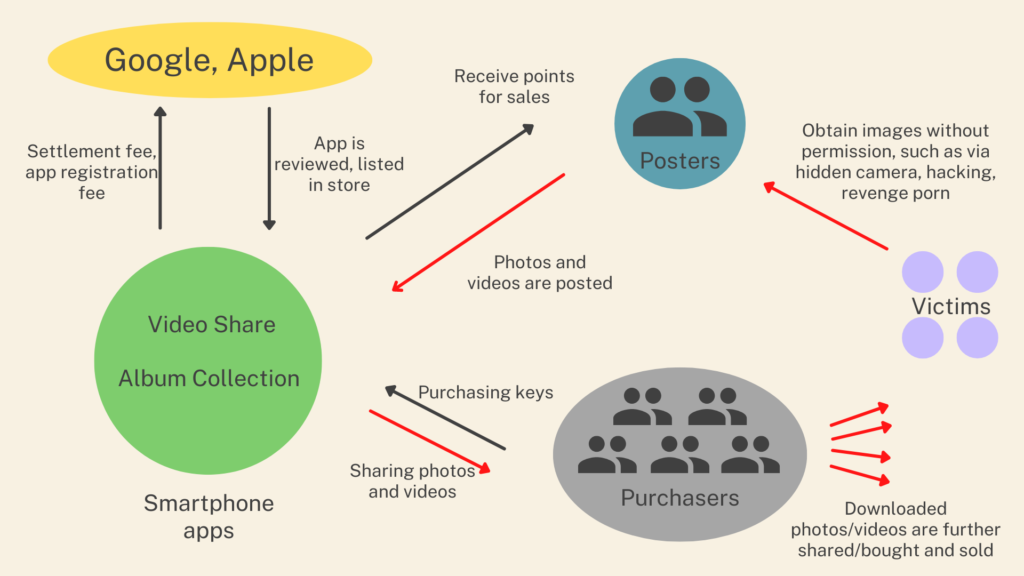339 posters have amassed 1,010,482 “customers” on Twitter (3)
2022.11.30 16:13 Mariko Tsuji
Those posting sexual images to pay-per-folder apps use Twitter to advertise their “products.”

(Illustration by qnel)
On Nov. 22, the day after the second article of this series was published, I was once again reminded of the horrifyingly persistently spread of images online.
I found that the folder containing photos and videos of A, the acquaintance who had come to me for help after her images leaked online, had been posted to the app again. There were 155 new downloads.
Sexual photos and videos continue to be posted online because those posting them get paid.
In order to download photos and videos, users must purchase in-app keys to unlock individual folders. Posters receive a portion of this fee as points, which can be exchanged for Amazon gift cards and other items. Points can also be exchanged for keys to download photos and videos from other posters, so they are a means to acquire photos and videos to be reposted as well.
Contributors eagerly advertise their “products” on Twitter to get people to download them.

Overview of the structure of harm caused by the apps. Red arrows indicate the flow of photos and videos.
“That kind of effort is rare around here”
As reported in the previous article, sexual photos and videos are bought and sold on the apps “Video Share” and “Album Collection.”
Each folder posted on the application is named with a random combination of letters and numbers.
The poster then tweets the name to help people find their folder among the myriad on the app. The tweet will often include a picture of the subject’s face, alongside a description their physical attributes and other information intended to encourage people to purchase the folder.
A’s photos and videos were also advertised on Twitter. The poster had about 2,400 followers and tweets more than 60 times per day. Most of their tweets included a picture of the victim’s face. In each tweet, they wrote, “Please follow and retweet.”
I contacted the poster directly on Twitter and told them to delete the folder containing A’s images and the tweets promoting it. The poster immediately replied, “I deleted them. Thank you for contacting me.” The two tweets advertising A’s folder were deleted.
However, when I looked in the app, the folder itself had not disappeared.
The next morning, the contributor was still tweeting to promote the folders they had posted.
“Good morning. I’m doing my best to post a lot to reach those who use Twitter in the morning, noon, or night. I’m trying to ensure the posts aren’t repetitive. That kind of effort is rare around here.”
They showed no sign of remorse.
Advertising with “If I post new bath footage tonight, will anyone buy again?”
What kind of person has the nerve to obtain and post sexually explicit photos without permission in order to make money? A Twitter search for the keywords “Video Share” and “Album Collection” brings up tweets that brazenly advertise such actions despite their illegality.
“I’ll be uploading my favorites list! I’ll do my best to provide good stuff!”
“A very beautiful woman worth using a key on — please like and retweet.”
Some tweets rated folder content with terms such as “recommended” or “rare,” as well as with star marks.
Folders that show the subject’s identity — such as those containing uncensored footage or the subject’s social media accounts — are popular. One contributor even charged an additional fee for sharing such folders.
“For those who want uncensored images and [social media] account info: 1,000 yen via PayPay or 1,500 yen and up via Amazon gift card.”
One poster was even more underhanded. They had been taking photos via hidden cameras in baths and toilets and posting them to the apps.
“If I post new bath footage tonight, will anyone buy again? I’m looking for repeaters.”
The tip of the iceberg
The huge number of tweets promoting these images can be seen using Yahoo!’s real-time search service.
A search at 4:50 p.m. on Nov. 27 revealed 1,702 tweets posted with the keyword “Video Share” in the past 24 hours; over seven days, 9,626; and over 30 days, 28,396. For “Album Collection,” there were 1,952 in the past 24 hours; over seven days, 10,618; and over 30 days, 27,355.
How many users were behind this large number of tweets?
Since I became aware of these tweets, I have spent roughly an hour almost every day gathering information on these Twitter accounts. I found a total of 339 accounts promoting folders posted to Video Share and Album Collection.
These include accounts that appear to have been created by the same person. Creating multiple accounts is a countermeasure against having one’s account suspended for tweets that violate Twitters terms of service, such as those advertising illegal content. The posters called these backups their “refuge accounts.”
The 339 accounts had a total of 1,014,482 followers — there were over 300 “sellers” with over 1 million “customers.” The greatest number of followers for a single account was 42,000. There were also 30 accounts with more than 10,000 followers.
These are the figures my investigation revealed over the course of roughly one month. They are probably only the tip of the iceberg of what’s really going on.
To be continued.
Uploaded and Re-Uploaded: All articles
 Newsletter signup
Newsletter signup